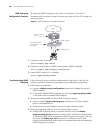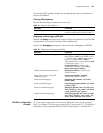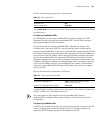Configuring PIM-SM 193
information of the router to build the RP-rooted shared tree (RPT). This helps to
reduce the bandwidth occupied by data packets and control packets, and reduces
the process overhead of the router. Multicast data flows along the shared tree to
the network segments. When data traffic is sufficient, the multicast data flow
switches over to the SPT (Shortest Path Tree) rooted on the source. This reduces
network delay. To perform the RPF check, PIM-SM does not depend on the
specified unicast routing protocol but uses the present unicast routing table.
If your switch is using PIM-SM, you must configure candidate RPs and BSRs. The
BSR is responsible for collecting the information from the candidate RP and
advertising the information.
Configuring PIM-SM is described in the following sections:
■ PIM-SM Operating Principles
■ Preparing to Configure PIM-SM
■ Configuring PIM-SM
PIM-SM Operating
Principles
The PIM-SM working process is as follows: neighbor discovery, building the
RP-rooted shared tree (RPT), multicast source registration and SPT switchover etc.
The neighbor discovery mechanism is the same as that of PIM-DM.
Build the RP shared tree (RPT)
When hosts join a multicast group G, the leaf routers send IGMP messages to
learn the receivers of the multicast group G. The leaf routers calculate the
corresponding rendezvous point (RP) for multicast group G, and then send join
messages to the node of a higher level toward the rendezvous point (RP). Each
router along the path, between the leaf routers and the RP, will generate (*, G)
entries in the forwarding table, indicating that all packets sent to multicast group
G are applicable. When the RP receives packets sent to multicast group G, the
packets will be sent to leaf routers along the path built and then reach the hosts.
In this way, an RP-rooted tree (RPT) is built as shown in the following figure.


















